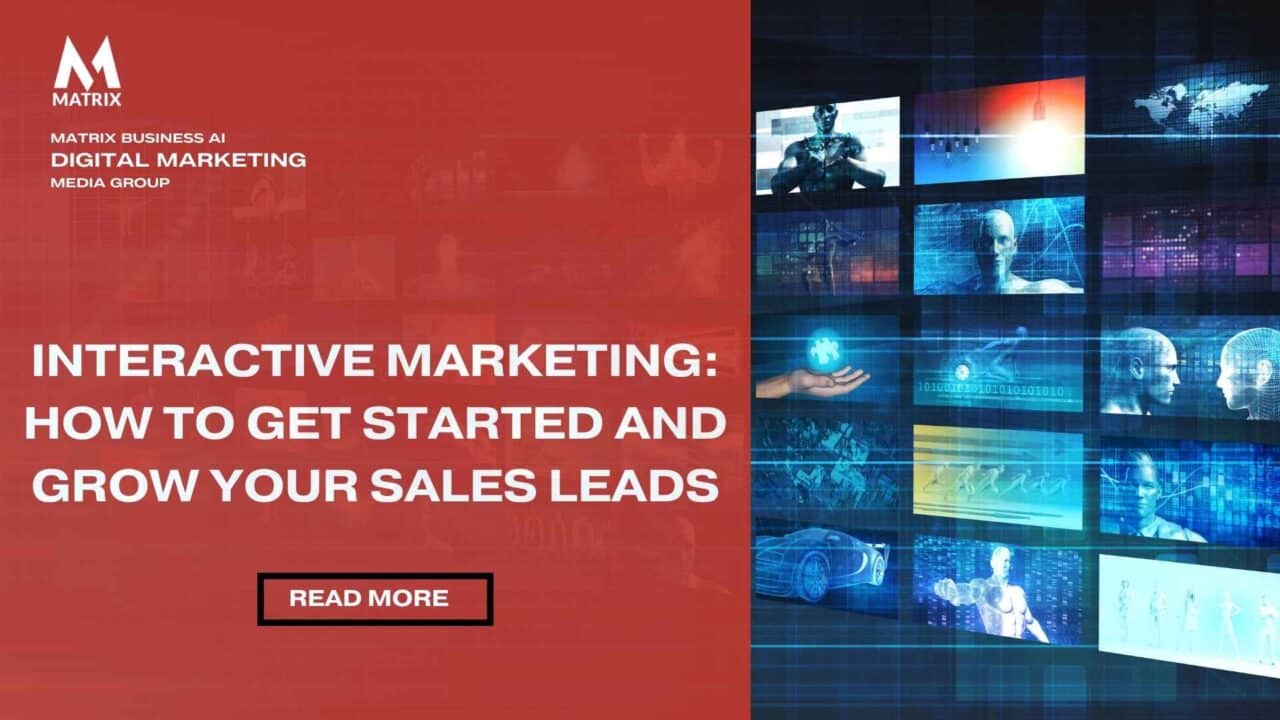Interactive marketing is a powerful change in marketing techniques for small businesses.
Interactive marketing and interactive technologies have existed for the past decade. However, not all marketers are aware of interactive marketing, which continues to grow in popularity with modern marketers.
Content marketing will continue to dominate the digital marketing landscape in 2024. However, its formats will change. To engage tech-savvy online visitors, your content marketing efforts must go beyond generic blog articles and keyword-rich product page descriptions.
This is where Interactive marketing and interactive technologies come into play.
They’ve already shaken the world of marketing to its core. Interactive marketing is such a popular term that it almost seems silly to be concerned about defining it. But that’s not the case. Part of the problem with implementing interactive marketing has been the unclear definition.
Like many buzzwords, meanings and definitions are all over the place. Just talk about inbound marketing. If you ask ten people about interactive marketing, you will get ten different answers.
For this post, interactive marketing is defined as any method that allows the prospect or customer to provide immediate feedback to the marketer. This feedback can come in many forms, including orders, requests for information, customer service, survey answers, and purchases.
Interactive marketing relies on the Internet as a link between customers and marketers. When you research a purchase, where do you go?
It gives the potential customer the highest degree of freedom and choice ever possible and seeks to create the ultimate form of partnership between product sellers and buyers.
Interactive marketing overcomes many of the weaknesses of traditional advertising. It will include a broad range of media, from simple services such as 800 numbers online order forms to complex media such as interactive television and virtual reality.
Content generation has become a significant challenge.
Content generation has become a significant challenge for businesses, with the demands of constant updates, fresh ideas, and maintaining quality across multiple platforms. Many marketers, like Jenn, find themselves overwhelmed, struggling to keep up with their content calendars while ensuring each piece resonates with the audience.
Enter Matrix’s AIContentPad, a game-changing solution that simplifies the entire process. AIContentPad delivers high-quality content faster than traditional methods, and its adaptability makes it perfect for a wide range of needs—from blog posts to whitepapers, emails, and social media content.
By leveraging the power of AI, AIContentPad not only saves time but significantly cuts costs compared to outsourcing or hiring additional staff. Marketers like Emily, who have already adopted AIContentPad, produce top-tier content without burnout.
It offers a seamless, efficient way to manage content creation while ensuring you stay ahead of the competition. In an era where time is money, Matrix’s AIContentPad is proving to be the future of content generation, offering a smarter, cheaper, and faster solution for businesses everywhere.

Most of this might seem painfully obvious. But the only more considerable pain has been the losses racked up by so many ill-conceived Ventures. This post will address some of those issues and discuss how to develop strategies and programs that will use interactive media to move products, build your customer bases and relationships, grow your business, and make money.
How interactive marketing differs from traditional marketing
The table below shows the contrast between traditional and interactive marketing. Look at each of these characteristics below.
Monologue vs. Dialogue vs. Conversational AI
Traditional advertising is a one-way process where the seller of a product or service transmits a message to potential buyers. This is a monologue, which means one direction. Interactive marketing is a dialogue.
It is not advertising speaking to consumers but rather advertisers and consumers speaking together, having a conversation. The seller or buyer can initiate the contact, which can also stop at any time by either party.
Rigid versus flexible scenario
Traditional forms of media are built around a linear process, with a prescribed beginning, middle, and end. A television commercial always starts the same way. While the viewer can change the channel or mute the sound, he or she cannot manipulate anything about the message or how it is presented. Interactive marketing is different.
It offers A/B or a variety of navigation paths. For example, anytime the prospect decides to purchase the product or service, he or she can switch to the purchase mode without viewing the remainder of the message. Likewise, the prospect may view an in-depth listing of product specifications or choose the quick view.
Passive activity versus participatory activity
Much of the current advertising is limited to those engaged in other activities such as researching the internet, watching television, reading industrial trade magazines, and reading the morning paper.
This can be referred to as interruptive selling because it aims to distract the prospect from what he or she has focused on long enough to yield a promotional message.
Just think about the last time you received a phone call you weren’t expecting or got something in your email inbox that you didn’t want.
By contrast, interactive marketing involves the prospect as a critical part of the promotional equation. It starts with the decision to better target advertising at those who will be most receptive and continues with techniques to draw the prospect in and receive immediate feedback from him or her through dialogue. Today’s dialog may be automated with email messages, direct selling, or artificial intelligence (AI).
Human management vs. heuristic management
People value art and marketing as the most important elements in a successful outcome. But humans also share one harmful trait: We repeatedly make the same mistake. We do this because we are cybernetic creatures and, as such, fall into repetitive habit patterns.
These habits can benefit us or have the opposite effect. Depending on how we approach the process, we can be a program for either failure or success.
By contrast, heuristic systems are designed to learn from their own mistakes and those of others. We can see this in early-stage artificial intelligence, which is still in its infancy in many industries.
Like Six Sigma techniques, a gradual improvement is a certainty because heuristic systems may make a mistake, but if programmed correctly, they will make each mistake only once.
But don’t humans learn from their mistakes, and therefore, aren’t they heuristic systems? The answer is both yes and no. Most of us try to learn from our mistakes, but we also bring our prejudice, preconceptions, and neuroses into the decision-making process.
It is human nature, and we don’t turn off our human nature when we wear our marketing hats. This is why you see people repeatedly make the same mistake.
Slow feedback versus instant feedback
No matter how well-intentioned, traditional marking systems often suffer from information bottlenecks. They’re just not efficient. The response and transaction data needed to make quality decisions take time to move through channels.
The information must be captured, compiled, and sent from point A to point B before it can be correctly used to impact the process.
Interactive Marketing Systems usually capture such data instantaneously. The modern marketer receives the information in real time after transactions are completed. Updates and data are possible moment by moment, and orders are directly tied to him or her. Content Translation Services: A Competitive Advantage for Your Business
For example, an order from an e-commerce website can immediately drop an item from inventory when it sells out. Visitors will see no out-of-stock message because they will only see items available for immediate shipment.
Advertiser-driven vs. consumer-driven
Timing has always been a critical element in advertising receptivity. Marketing isn’t only a process of creating demand. It is also a process of putting the appropriate message before the prospect when such demand exists. What are CMOs Top Priorities in 2023?
“The new marketing miracle is selling the right thing to the right person at the right time.” Digital marketing can help us do this.
As marketers, we often have no control over when a prospect will need a particular product or service. We must be there when the demand exists, whether at 1:30 p.m. or 1:30 a.m. or on a Monday or a Saturday. This 24-hour online access to products and services promotional channels is one of the most important benefits of digital marketing.
Delayed gratification vs. instant gratification
Remember the days of ordering by telephone or mail or being told to wait 6 to 8 weeks for delivery or something you wanted? Today, we’re talking about delivery within an hour. Those days are gone; the internet has allowed customers to go from product interest to product order in seconds.
Consumers will no longer have to wait weeks for delivery, and the new question will be whether they want it today or within an hour.
The benefits and challenges of interactive marketing
Digital marketing offers probably the most opportunity for modern marketers today. There are many benefits to be gained in e-marketing and interactive marketing.
- A deeper and more personal relationship with your customer.
- Faster and more accurate product feedback. It would be best to look for ways to use the internet and other electronic media to allow users to help design your products and services. Social media platforms like Twitter, Facebook, and Linkedin are great platforms for this. This instant feedback tends to be honest and sincere and can be enormously helpful in making sure that what you create is exactly what your customers want.
- Strong return on your marketing investment. Interactive marketing programs tend to be expensive to set up and very cost-effective to operate. If you do it right, your cost per lead and sale cost will decrease. Furthermore, you can experience substantial increases in volume at a lower incremental cost. Whether you’re a startup funded by a venture capital firm or a small business, an aggressive digital marketing program can greatly boost your company’s valuation.
- Broader market reach. Perhaps the most significant impact of the Internet is how it can allow any company located anywhere to engage in commerce with any other company or individual on the planet. The model is no longer to build retail outlets in hundreds of cities. Today’s e-model is to create a robust electronic present that will expose you to tens of millions of people in months.
- Ability to service less-profitable tiers of customers and prospects. You can use interactive technologies to fill the needs of customers and prospects who are not profitable enough to warrant attention from your expensive field or inside sales resources.
- Greater operational efficiencies. Electronic transactions have several advantages over traditional paper-based transactions. First, they happen much faster. Second, they tend to be more accurate since the customer often enters information that is not subject to interpretation. Third, they are far less expensive. These efficiencies allow you to achieve higher product margins or more significant volumes by passing the savings on to your customers.
Problems with interactive marketing and the number of specific pitfalls to avoid
Despite all the hype, there are plenty of problems with interactive marketing and several specific pitfalls to avoid. Why you’re always subject to the law of unintended consequences, it is wise to build your programs to avoid these problems:
- Interactive marketing may not provide a good return on investment. Many online marketing programs and websites are losing money or providing only minimal profits. For example, initial costs for small business websites can start from $5,000 to tens of thousands of dollars, and larger businesses spend much more. Without a well-designed plan for generating results, these Investments can be hard to recoup.
- It can separate you from your customers and prospects. Technology’s dark secret is that it is too often used to build a barrier between a company and its customers. Interactive marketing is meant to enhance the user experience, not to be a barrier. To prevent this, it is very important for you to design your systems to allow people to transition quickly from the electronic experience to dialog with customer support or your internal sales staff.
- It can subject you to the whims of marketing technology. Marketing technology is fickled and can wreak havoc on your best-laid plans. Websites go down, email bounces back, ISPs have outages, spam filters are better, or you get stuck with a nasty computer virus. Even the biggest and better-financed operations like Google and Amazon have occasional glitches. No matter how well you plan, you can expect your share.
- Interactive marketing can divert your focus from other vital areas. The adoption curve for technologies is such that there is a danger of pushing too many resources toward interactive channels too quickly. There is always an opportunity cost in shifting resources. How many cases will it be well worth? But many times, it will not be. There’s no specific advice I can provide without knowing your specific circumstances. But in general, it is better to be on the bleeding edge than the bleeding edge of new technology. Finding that point is the trick.
Wrap up about interactive marketing.
This dynamic marketing environment for the past 30 years. During that period, we moved from the mass-marketing era to the target marketing era to 1:1 interactive marketing.
New sales and marketing technologies and economic drivers have shifted marketing strategies not only in marketing methods but also in our thoughts about the subject.
One of marketing technology’s most noticeable impacts is how it has empowered consumers. Individually and collectively, they are becoming smarter unless they allow themselves to act as so many sheep waiting to be shared by skill for the marketer who loses his coat.
The Internet has taken control of information flow out of the hands of people selling products and put it in the hands of people buying products. You can’t beat the system because if you refuse to make your information available, your competitor certainly will, and you will lose customers.
I hope you will find this post helpful in your quest to become a successful interactive marketing practitioner. It is a collection of ideas, strategies, and techniques honed from years of experience on both the client and agency sides.
We’re listening.
Have something to say about your thoughts on interactive marketing?
Please share it with us on Facebook, Twitter or LinkedIn.
General FAQ’s
What is interactive marketing?

Interactive marketing is a one-to-one practice that centers on individual customers’ and prospects’ actions. It involves marketing programs triggered by customers’ behaviors and preferences, which makes it a significant shift from traditional campaign-based marketing efforts.
Why is interactive marketing important?

With interactive marketing, organizations increase their chances of meeting customer needs because they already show an interest in the product, and marketers can respond to their actions. Interactive marketing reduces risk and increases sales because it is rooted in customer behaviors and desires.
What are the interactive marketing services?

Interactive marketing, sometimes called trigger-based or event-driven marketing, is a marketing strategy that uses two-way communication channels to allow consumers to connect with a company directly. Although this exchange can occur in person, it has increasingly occurred almost exclusively online through email, social media, and blogs in the last decade.
What are interactive marketing advantages?

The benefits of interactive marketing can be significant. Increase sales: Interactive marketing increases the odds you’ll deliver what the consumer needs, leading to a sale. It can also increase sales by recommending related items, resulting in the buyer tacking on other items that fit their purchase.

